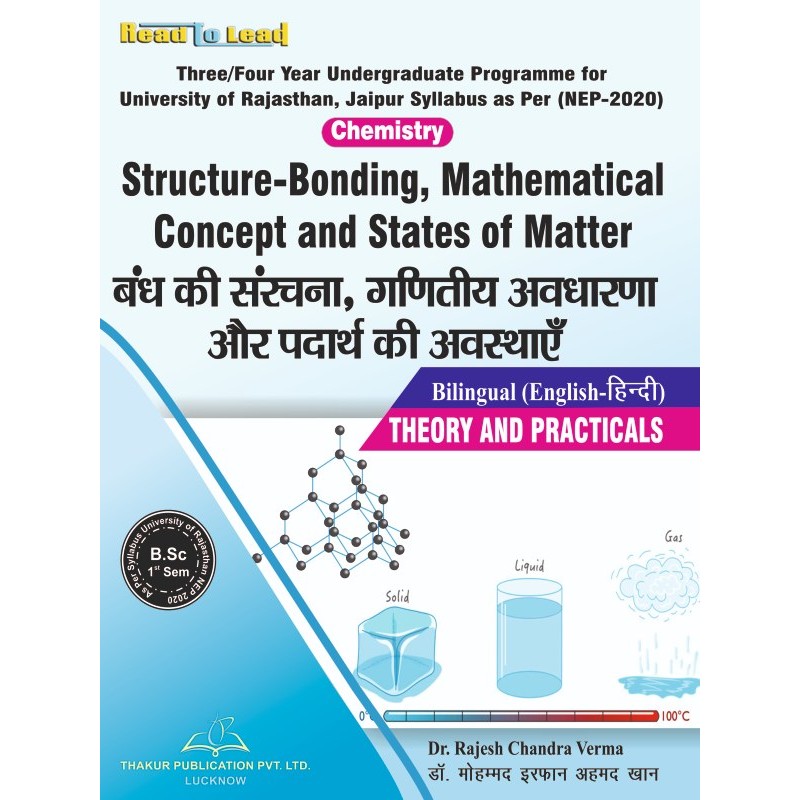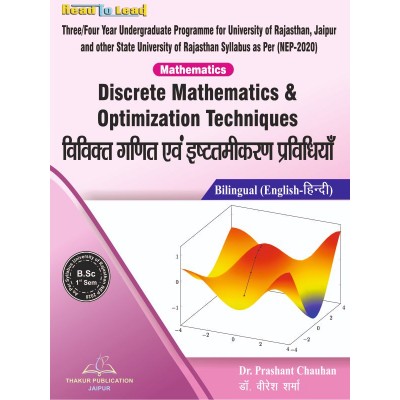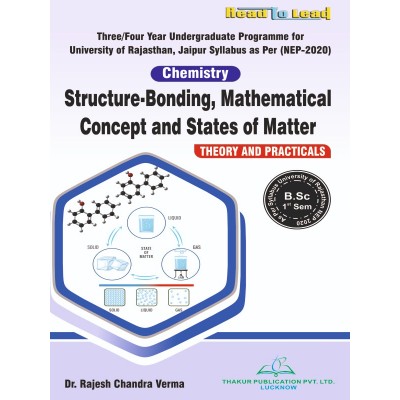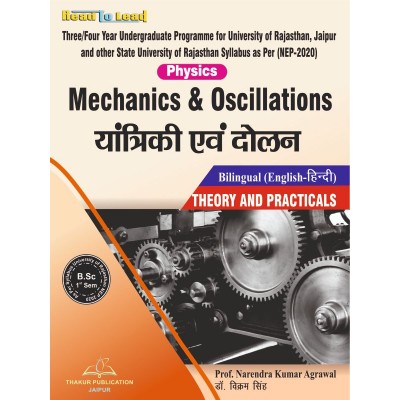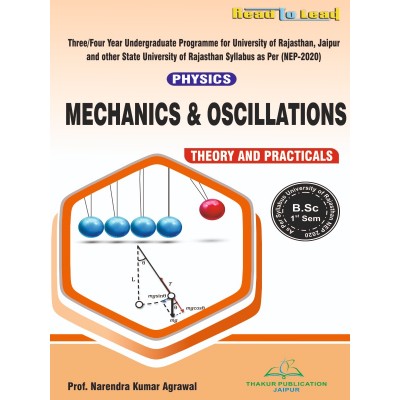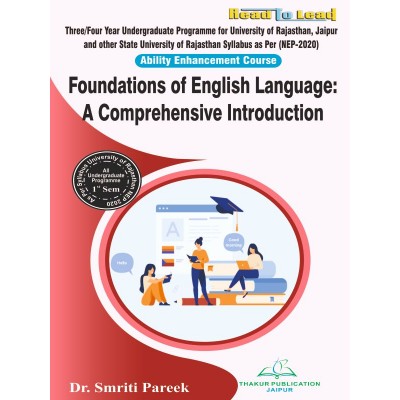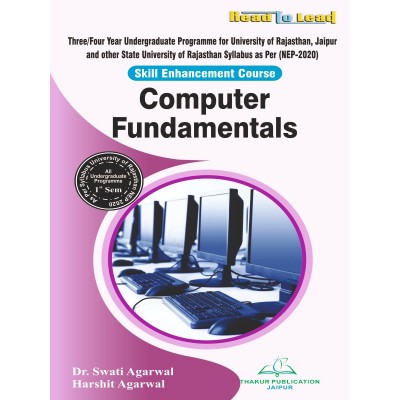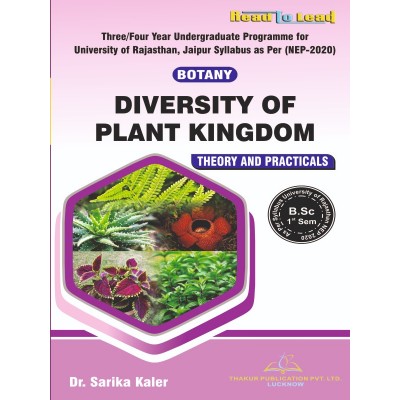(Chemistry) Structure-Bonding, Mathematical Concept and States of Matter Bilingual B.Sc 1st Sem NEP-2020
Tax excluded
Click below to Buy E-Book Edition:
Buy Latest (Chemistry) Structure-Bonding, Mathematical Concept and States of Matter ( बंध की संरचना,गणितीय अवधारणा और पदार्थ की अवस्थाएँ ) Book in Bilingual Edition ( Both English and Hindi ) for B.Sc 1st Semester University of Rajasthan, Jaipur NEP-2020 By Thakur publication.
AUTHORS : Dr. Rajesh Chandra Verma , Dr. Moh. Erfan Ahamad Khan
ISBN : 9789357559522
Syllabus
Course Code: CHM-51T-101
Structure-Bonding, Mathematical Concept and States of Matter
lajpuk&ca/k] xf.krh; vo/kkj.kk vkSj inkFkZ dh voLFkk,¡
Unit-I
Ionic Solids: General characteristics of ionic bonding, Ionic structures, radius ratio effect and coordination number, limitation of radius ratio rule, Lattice enthalpy and Born-Lande equation for calculation of Lattice Enthalpy (no derivation), Born-Haber cycle and its applications, Solvation enthalpy and solubility of ionic solids, polarizing power and polarizability, Fajan’s rule, Lattice defects, semiconductors.
vk;fud Bksl& vk;fud ca/k dh lkekU; fo'ks"krk,a] vk;fud lajpuk,a] f=T;k vuqikr çHkko vkSj milgla;kstd la[;k] f=T;k vuqikr fu;e dh lhek] tkyd ,UFkSYih ¼dksbZ O;qRifÙk ugha½] cksuZ&gScj pØ vkSj blds vuqç;ksxksa dh x.kuk ds fy, tkyd ,UFkSYih vkSj cksuZ&ySaMs lehdj.k] vk;fud Bkslksa dh foyk;du ,UFkSYih vkSj ?kqyu'khyrk] /kzqohdj.k {kerk vkSj /kzqohdj.k] Qtku dk fu;e] tkyd nks"k] v/kZpkydA
Metallic Bond: Free electron, valence bond and bond theories.
Weak Interactions: Hydrogen bonding, Van der Waals forces.
/kkfRod ca/k& eqDr bysDVª‚u] la;kstdrk ca/k vkSj ca/k fl)karA
nqcZy var%fØ;k,¡& gkbMªkstu ca/k] oku Mj okYl cyA
Unit-II
Covalent Bond: Valence bond theory and its limitations, Directional character, Hybridization. Valence shell electron pair repulsion (VSEPR) theory to NH3, H3O+, SF4, CIF3, , H2O.
lgla;kstd ca/k& la;kstdrk ca/k fl)kar vkSj bldh lhek,a] fn'kkRed xq.k] ladj.kA NH3, H3O+, SF4, CIF3, , H2O ds fy, la;ksth dks’k bysDVª‚u ;qXe çfrd"kZ.k (VSEPR) fl)karA
Molecular Orbital Theory: LCAO method, bonding, nonbonding and anti-bonding MOs and their characteristics for combinations of atomic orbitals, MO treatment of homonuclear and heteronuclear (CO and NO) diatomic molecules. Comparison of VB and MO approaches.
vk.kfod vkWfcZVy fl)kar& LCAO fof/k] ca/k] vkca/k vkSj ,aVh&c‚fUMax MOs vkSj ijek.kq v‚fcZVYk ds la;kstu ds fy, mudh fo'ks"krk,a] lekukfHkdh; vkSj fo"ke ukfHkdh; ¼CO vkSj NO½ f}ijek.kqd v.kqvksa dk MO vfHkfØ;kA VB vkSj MO –f"Vdks.k dh rqyukA
Multicenter bonding in electron deficient molecules, bond strength and bond energy, ionic character in covalent compounds, calculation of percentage ionic character from dipole moment and electronegativity difference.
bysDVª‚u dh deh okys v.kqvksa esa cgqdsaæh; ca/k] ca/k {kerk vkSj ca/k ÅtkZ] lgla;kstd ;kSfxdksa esa vk;fud xq.k] f}/kzqo {k.k vkSj fo|qr_.kkRedrk varj ls çfr'kr vk;fud xq.k dh x.kukA
Unit-III
Mathematical Concepts: Logarithmic relations, curve sketching, linear graphs and calculations of slopes, differentiation of functions like kx, ex, xn, sinx and log x; maxima and minima, partial differentiation and reciprocity relations, integration of some useful/relevant functions; permutations and combinations, factorials, probability, Matrices and Determinant.
xf.krh; vo/kkj.kk,¡& y?kqx.kdh; laca/k, oØ js[kkfp=, jSf[kd xzkQ vkSj izo.krk dh x.kuk kx, ex, xn, sinx vkSj log x; tSls dk;ksaZ dk foHksnu, eSfDlek vkSj fefuek, vkaf'kd vodyu vkSj ikjLifjdrk laca/k, dqN mi;ksxh/çklafxd dk;ksaZ dk ,dhdj.k, ØeifjorZu vkSj la;kstu, HkkT;, laHkkO;rk, vkO;wg vkSj fu/kkZjdA
Liquid State: Intermolecular forces, structure of liquids (a qualitative description). Structural differences between solids, liquids and gases, Liquid crystals: Difference between liquid crystal, solid and liquid.
rjy voLFkk& varjvkf.od cy] rjy inkFkZ dh lajpuk ¼,d xq.kkRed fooj.k½A Bksl] nzo inkFkZ vkSj xSlksa ds chp lajpukRed varj] nzo fØLVy& nzo fØLVy] Bksl vkSj nzo ds chp varjA
Solid State: Definition of space lattice, unit cell.
Laws of crystallography- (i) Law of constancy of interfacial angles (ii) Law of rationality of indices (iii) Law of symmetry, Symmetry elements in crystals.
Bksl voLFkk& f=foe tkyd] bdkbZ dksf'kdk dh ifjHkk"kkA
fØLVyksxzkQh ds fu;e& ¼i½ varjkQyd dks.kksa dh fLFkjrk dk fu;e ¼ii½ lwpdkadksa dh rdZlaxrrk dk fu;e ¼iii½ lefefr dk fu;e] fØLVy esa lefefr rRoA
Basic concept of X-ray diffraction by crystals. Derivation of Bragg’s equation, Determination of crystal structure of NaCl and CaCl (Laue’s method and powder method), Defects in solids.
fØLVy }kjk ,Dl&js foorZu dh ewy vo/kkj.kkA czSx lehdj.k dh O;qRifÙk] NaCl vkSj CaCl dh fØLVy lajpuk dk fu/kkZj.k ¼ykm fof/k vkSj ikmMj fof/k½] Bksl inkFkksaZ esa nks"kA
Unit-IV
Gaseous State: Postulates of kinetic theory of gases, deviation from ideal behavior, van der Waals equation of state.
Critical Phenomenon: PV isotherms of real gases, continuity of states, the isotherms of van der Waals equation, relationship between critical constants and van der Waals constants, the law of corresponding states, reduced equation of state.
xSlh; voLFkk& xSlksa ds xfrt fl)kar dh vfHk/kkj.kk,¡] vkn'kZ O;ogkj ls fopyu] voLFkk dk oku Mj okYl lehdj.kA
egRoiw.kZ ?kVuk& okLrfod xSlksa ds PV lerkijs[kk] voLFkkvksa dh fujarjrk] oku Mj okYl lehdj.k ds lerkijs[kk ] egRoiw.kZ fLFkjkad vkSj oku Mj okYl fLFkjkad ds chp laca/k] lacaf/kr voLFkkvksa dk fu;e] voLFkk dk de lehdj.kA
Molecular Velocities: Root mean square, average and most probable velocities. Qualitative discussion of the Maxwell’s distribution of molecular velocities, collision number, Mean free path and collision diameter, Liquification of gases (based on Joule-Thomson effect).
Colloidal State: Definition of colloids, classification of colloids.
vk.kfod osx& ewy ek/; oxZ] vkSlr vkSj lokZf/kd laHkkfor osxA eSDlosy ds vk.kfod osx] la?kV~V la[;k] ek/; eqDr iFk vkSj la?kV~V O;kl] xSlksa ds æohdj.k ¼twy&Fk‚elu çHkko ds vk/kkj ij½ ds forj.k dh xq.kkRed ppkZA
dksykbMy voLFkk& dksykbM dh ifjHkk"kk] dksykbM dk oxhZdj.kA
Solids in liquids (sols): properties-kinetic, optical and electrical, stability of colloids, Protective action, Hardy-Schulze law, gold number.
Liquid in solids (gels): classification, preparation and properties, inhibition, general applications of colloids.
Liquids in liquids (emulsions): types of emulsions, preparation, Emulsifier.
rjy inkFkksaZ esa Bksl ¼lksy½& xq.k&xfrt] izdkf’kd vkSj fo|qr] dksykbM~l dh fLFkjrk] laj{kh fØ;k] gkMhZ&'kqYt fu;e] Lo.kZ la[;kA
Bksl esa rjy inkFkZ ¼tSy½& oxhZdj.k] rS;kjh vkSj xq.k] fu"ks/k] dksykbM ds lkekU; vuqç;ksxA
rjy inkFkksaZ esa rjy inkFkZ ¼ik;l½& ik;l ds çdkj] rS;kjh] ik;lhdkjd A
Chemistry Lab
Organic Chemistry
Laboratory Techniques 3 marks
a) Determination of melting point (naphthalene, benzoic acid, urea, etc.); boiling point (methanol, ethanol, cyclohexane, etc.): mixed melting point (urea-cinnamic acid, etc.).
b) Crystallization of phthalic acid and benzoic acid from hot water, acetanilide from boiling water, naphthalene from ethanol etc.; Sublimation of naphthalene, camphor etc.
dkcZfud jlk;u
ç;ksx'kkyk rduhd
,½ xyukad ¼uS¶Fkyhu] csatksbd vEy] ;wfj;k] vkfn½ dk fu/kkZj.k] DoFkukad ¼esFksu‚y] bFksu‚y] lkbDyksgsDlsu] vkfn½& fefJr DoFkukad ¼;wfj;k&fluSfed vEy] vkfn½A
ch½ xeZ ikuh ls FkSfyd vEy vkSj csatksbd vEy dk fØLVyhdj.k] mcyrs ikuh ls ,flVkfuykbM] ,Fksu‚y ls uS¶Fkyhu vkfn] uS¶Fkyhu] diwj vkfn dk m/oZikruA
Qualitative Analysis 7 marks
Identification of functional groups (unsaturation, phenolic, alcoholic, carboxylic, carbonyl, ester, carbohydrate, amine, amide, nitro and hydrocarbon) in simple organic compounds (solids or liquids) through element detection (N.S and halogens)
xq.kkRed fo'ys"k.k
rRo igpku ¼N.S vkSj gSykstu½ ds ek/;e ls ljy dkcZfud ;kSfxdksa ¼Bksl ;k rjy inkFkZ½ esa dk;kZRed lewgksa ¼vlar`fIr] Qsuksfyd] ,Ydksgfyd] dkcksZfDlfyd] dkcksZfuy] ,LVj] dkcksZgkbMªsV] ,sehu] ,sekbM] ukbVªks vkSj gkbMªksdkcZu½ dh igpku
Physical Chemistry
Viscosity and Surface Tension: 10 marks
a) To determine the viscosity/surface tension of a pure liquid (alcohol etc.) at room temperature. (Using the Ostwald viscometer/stalagmometer).
b) To determine the percentage composition of a given binary mixture (acetone and ethyl methyl ketone) by surface tension method.
c) To determine the percentage composition of a given mixture (non-interacting systems) by viscosity method.
d) To determine the viscosity of amyl alcohol in water at different concentration and calculate the excess viscosity of these solutions.
HkkSfrd jlk;u
';kurk vkSj i`"B ruko&
a½ dejs ds rkieku ij 'kq) rjy ¼,Ydksgy vkfn½ dh ';kurk/i`"B ruko fu/kkZfjr djus ds fy,A ¼vksLVokYM ';kurkekih/fcanqekih dk mi;ksx djds½A
ch½ i`"B ruko fof/k }kjk fdlh fn, x, ckbujh feJ.k ¼,lhVksu vkSj ,fFky esfFky dhVksu½ dh çfr'kr lajpuk fu/kkZfjr djukA
x½ ';kurk fof/k }kjk fdlh fn, x, feJ.k ¼vU;ksU;fØ;kghu ç.kkyh½ dh çfr'kr lajpuk fu/kkZfjr djukA
?k½ fofHkUu lkaærk ij ikuh esa ,sfey ,Ydksgy dh ';kurk fu/kkZfjr djus vkSj bu foy;uksa dh vfrfjDr ';kurk dh x.kuk djus ds fy,A







